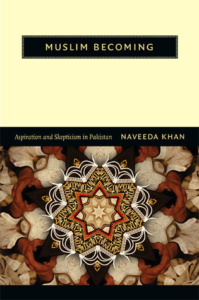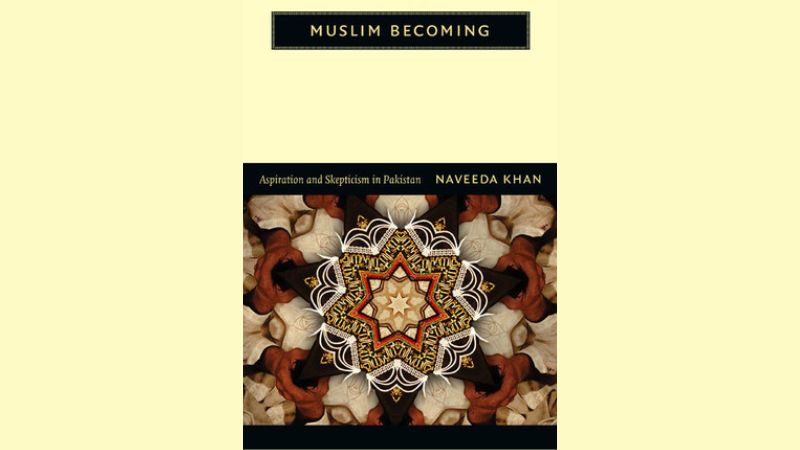A review of Naveeda Khan’s book Muslim Becoming published in “The Book Review“

I wanted to learn what it meant to know Islam in Pakistan and why this knowing was so easily brushed aside.
It is a welcome addition to the rather scant literature on Islam, identity and Muslimness in contemporary Pakistan. Khan begins by presenting a debate between four librarians of differing religious persuasions. Deep within the stacks of the Provincial As- sembly Library, four men take part in a dis- cussion that highlights the marked differ- ences in their belief systems. Of the four, one is a Shia and the other three Sunni. Among the Sunnis, one identifies himself as a Deobandi, one as a follower of Ahl-e-Hadis sect, and the third as a Barelvi. Akbar, the follower of Ahl-e-Hadis school of thought, speaks at length of the superiority of their mosques as “they allowed laymen to give ser- mons and encouraged women’s participation in congregational prayer”. Despite his reverence for mosque culture, Akbar is derisive of the thought of praying at the Prophet’s mosque in Medina.
It is commendable to pray at the Prophet’s mosque, but it isn’t necessary. Some among us have made it into a re- quirement by saying such things as, the Prophet is alive there, he can hear your prayers and he can grant you your wishes. Such claims are bid’a. One cannot pray there until such time as this bid’a has been vanquished.
Naz, the Barelvi, challenges this notion with his claim of having ‘seen’ Â the Prophet in a dream, the first any of them has heard of such a thing from him. A Khan quickly adds, “Perhaps Naz’s previous silence on the matter was explained by the fact that to speak about such an experience in contemporary state (“..the signature of its colonial past and the disorder of the postcolony.”), major his- torical actors and events, along with the specificity of everyday life and the public culture of Lahore.
The book therefore presents the argument that the creation of Pakistan gave rise to the need to strive to be Muslim. Khan also traces the philosophy of Iqbal in con- junction with the early constitution makers of the country to highlight their intention of maintaining an open future to enable striving and experimentation on the self. In a rather candid statement, Khan states:
“…while Iqbal’s influence was quite wide- spread within Pakistan, it was not always for the nation’s good and the working out of his thinking might have depleted its capacious- ness.”
The construction and maintenance of mosques sets the scene for such experimen- tations, as do the theological arguments that are a part of everyday life. Khan uses the example of the Ahmaddiya community of Pakistan to present the broad scope and potential for distaste that lies within the journey of aspiration (“I explore how the state’s constitutional and legislative treatment of Ahmadis both upheld an Iqbal-inflected aspiration and produced conditions of possibility for a proliferation of scepticism in relation to others within everyday life in Lahore.”)
An unavoidable aspect of Muslim becoming in Pakistan are the surprises that come up, unsettling established scholarly notions as well as social theory. Theological disputes and mosque-related struggles are examples of such ‘surprises’. The state’s re- lationship with both religion and daily life is also touched upon in the book. Khan argues that there has been a consistency in the state’s efforts to exert itself over Islam. Furthermore, daily life is relegated to the margins of state as it continues to meddle in the administration of mosques. Khan goes on to argue in defence of the hated ‘mulla’, saying there hasn’t been sufficient attention paid to the ways in which ‘they retain their vitality for Pakistan through their diagnos- tic attentiveness to everyday life in its com- plexity’.
Khan also delves into the popular culture and looks at fiction, political cartoons and other sources to showcase how mullas and mullahism are viewed by different seg- ments of Pakistani society. While Khan appears to be a neutral researcher, the attempts to empathize with the clerics become a little problematic at times. The truth is that today’s Pakistan is hostage to the over-imagi- nations of Pakistanis and Islamists often played out through violence. In a country where polio workers and girl students are being shot dead the discourse on religion has perhaps overstepped the theological boundaries and entered into the domain of power wielded through power. In fact the book’s perhaps not deliberate omission is the state’s subcontracting of its monopoly of violence to certain religious groups and factions that require a different kind of study.
In terms of the current state of affairs in Pakistan and its rocky future, the author hopes that her work becomes a means to understand how inhabiting Pakistan can mean allowing Muslims opportunities to reinhabit their tradition, make it newly perfect, and learn to live with doubts and scepticism. This is the most powerful message that emerges after a reading of this well re- searched book. The book is a must read for all scholars, researchers and lay readers alike.



